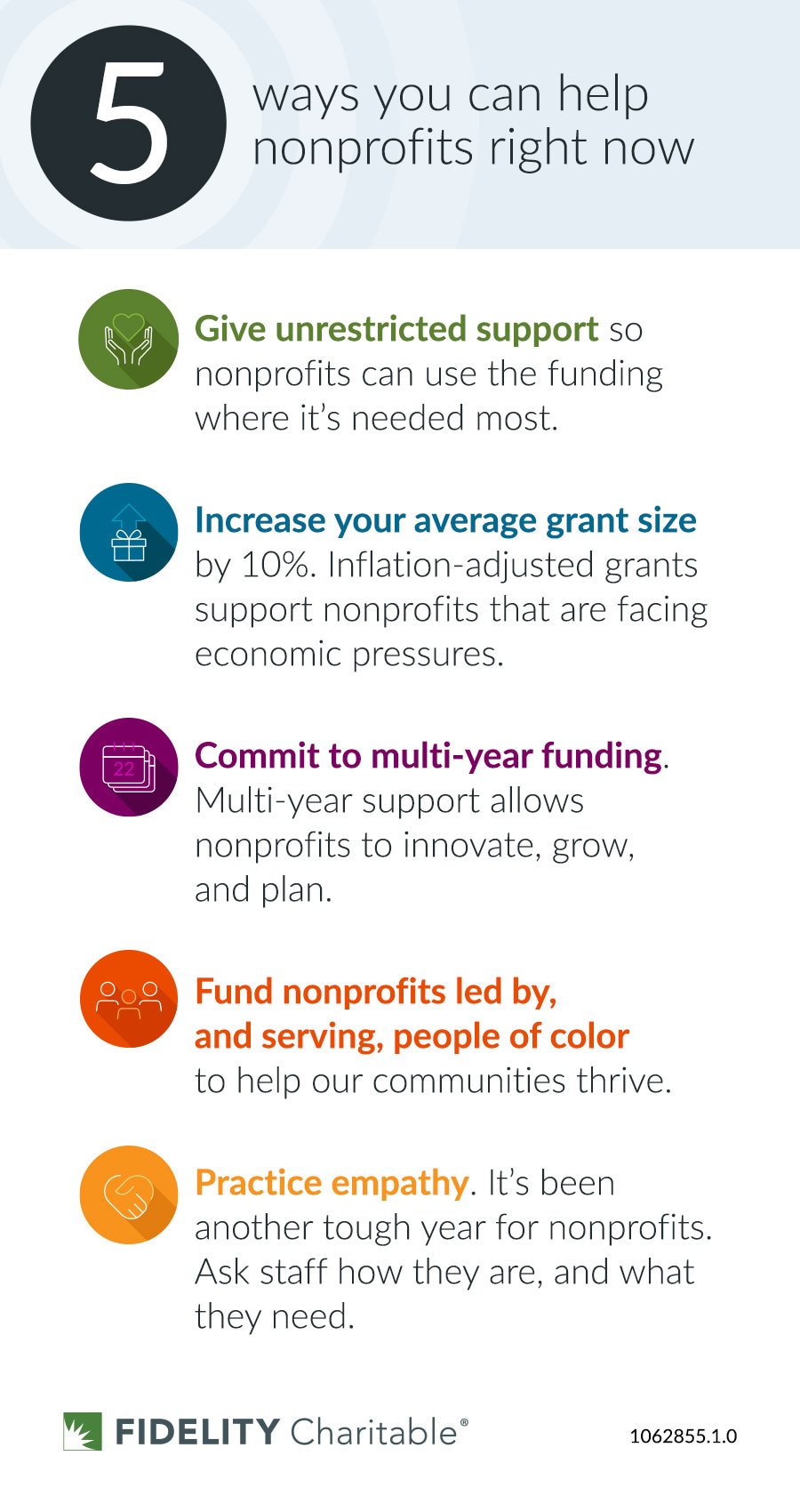Five ways to help nonprofits right now
Over the past three tumultuous years, nonprofits have shown great resilience and creativity in the face of both constant change and growing need. But just like us as individuals, nonprofits need a support system to thrive. Many nonprofits are still seeing increased need for their services compared to before the pandemic. On top of that, they’re managing tight budgets through high inflation, and trying to fend off staff burnout.
In short—they’re doing more with less.
At the Fidelity Charitable Trustees’ Initiative, which funds efforts to help nonprofit organizations maximize their impact, these conditions have shaped our approach to grantmaking during the past year. We focus on funding organizations that help nonprofits better meet their missions, whether with staff education and development, technology needs, or other supports that bolster the work of the entire social sector.
But as an individual donor, you too can give nonprofits a needed boost as they close out another difficult year, regardless of the cause area or type of nonprofit you support. Here are five ways you can help the nonprofits you care about right now.

1. Give unrestricted support
Why it’s important: Unrestricted support means you aren’t determining for the nonprofit how your donation will be spent. This allows the nonprofit the freedom to use the money where it’s needed most—whether that’s on a specific program need or something that supports the mission or the staff in general.
In 2022, 68% of our grant funding from the Trustees’ Initiative was for general support, rather than program-specific grants. For example, we made an unrestricted general support grant to the Institute for Nonprofit Practice. The organization plans to use the grant to expand its nonprofit leadership development programs, launch its Black Leadership Institute, and invest in its ability to assess and communicate its impact.
How to get started: You can give unrestricted support to a nonprofit through your Giving Account by recommending a grant and selecting the “where needed most” option for the designation.
2. Increase your average grant size by at least 10%
Why it’s important: Inflation is on everyone’s mind right now, and costs are rising for nonprofits just like they are for consumers. One example: food banks are scrambling to cope with the rising cost of groceries.
It’s also important to keep in mind that nonprofits are human-powered and typically spend at least 70% of their budgets on staffing. Nonprofit employees are facing the same upticks in their personal budgets as everyone else, but nonprofit organizations have a harder time raising salaries than for-profit businesses do. Nonprofit staff typically make below-market wages for their work already. The additional financial strain is forcing many nonprofit employees to leave the sector to find higher paying work elsewhere—leaving many nonprofits understaffed and less able to run essential programs. According to the National Council on Nonprofits, 42% of nonprofits surveyed reported staff vacancy rates of 20% or higher going into 2022.
Through the Trustees’ Initiative we’re committed to raising our average grant size to take inflation into account, and we’ve also made one-time grant increases to those nonprofits that received multi-year grants before the surge in inflation.
We are showing our grantees that we have their backs in this difficult time—and so can you.
How to get started: If you would typically give a nonprofit $500 per year, increase it to at least $550. If you’re in contact with the nonprofits you support, inquire about how their needs have changed given inflation.
3. Commit to multi-year support
Why it’s important: Nonprofits count on consistent support from donors to be able to reliably run programs and support staff year after year. This consistency becomes even more important in times of constant flux when nonprofits are pressed to be ever more flexible and responsive.
“To tackle today’s complex challenges, nonprofits are creating innovative programs and testing new ways to deliver their services to the people who need them most,” says Audrey Gillis, Senior Vice President of Advancement at the Institute for Nonprofit Practice. “What do we need the most? Flexible, multi-year support to fuel these services and respond to community needs.”
Having reliable support also gives nonprofits the freedom to operate outside of subsistence mode.
“Most nonprofits have small budgets and, because of this, struggle to have a growth mentality. Instead, they have a survival mentality,” says Armando Enrique Zumaya of Somos El Poder, another grantee organization. “How do we create social change with barely surviving nonprofits?”
In 2022, 70% of grants from the Trustees’ Initiative were multi-year commitments, including to Somos El Poder and the Institute for Nonprofit Practice.
How to get started: Ask the nonprofits you support about their longer-term needs and commit funds to support them for a period of years in your giving budget. You can give multi-year support to the nonprofits your care about by scheduling recurring grants in your Giving Account.
4. Add more nonprofits led by, and serving, people of color to your portfolio
Why it’s important: It’s essential to have community leaders making decisions about how to best support their own communities. Rising prices for food, housing and transportation are particularly stretching people living in poverty—a population that disproportionately includes people of color. But currently, only a small amount of overall charitable giving each year goes to organizations led by people of color. According to recent research by Echoing Green and the Bridgespan Group, the unrestricted net assets of Black-led organizations are 76% smaller than their white-led counterparts. This means that many nonprofit decisions about how to best support these communities are being made by those without close ties to them.
In 2022, 57% of Trustees’ Initiative funding went to organizations led by people of color. For example, we gave a general support grant to First Nations Development Institute to help build the fundraising capacity of Native-led nonprofits, educate donors on how to support Native-led causes, and more.
How to get started: You can find new nonprofits to support through resources such as GivingGap, which vets Black-founded nonprofits working on different causes, or HIPGive which offers opportunities to support Latinx-serving nonprofits across the Americas. JustFund has a “Find and Fund” feature to help you review short proposals and search for organizations serving communities of color. Or you can look up demographic information under the “Operations” section of a nonprofit’s GuideStar profile, which all Fidelity Charitable donors have access to through their Giving Account.
5. Practice empathy and support nonprofit workers
Why it’s important: Do you remember the grace we had for each other during the first few months of the pandemic? When it was okay for kids to walk into the background of Zoom calls, or for people to take a breather to take care of a loved one? Now is the time when nonprofit staff need that grace. Most nonprofit leaders don’t want to share this with you, but they are burned out from dealing with crisis after crisis. They’re facing increased demand for services while being short-staffed and concerned about how they will raise enough funding to meet the needs of their communities.
One way we’re showing our support for nonprofit workers is by funding the Human Services Providers Charitable Foundation. Our general support grant aims to strengthen the nonprofit human services workforce, as jobs at human service nonprofits are becoming increasingly difficult to fill.
How to get started: Next time you meet with a nonprofit, ask the staff how they’re doing personally and how you can support them, and practice patience if you encounter anything that isn’t running as smoothly as it could. Remember why we love philanthropy in the first place—supporting people and our communities! That includes the people who do this important work.
The Fidelity Charitable Trustees' Initiative announced its new grantmaking strategy in February 2024, to coincide with its new name: the Fidelity Charitable Catalyst Fund. Learn more about the work of this grantmaking program.

Tony Bowen
Vice President, Trustees' Philanthropy Fund
Tony Bowen has spent his career supporting nonprofits, donors, and foundations to better meet their visions and build more equitable and empowered futures for those with less access to power and resources. His work spanned from philanthropic and nonprofit operations to sector-strengthening programming during his time in management consulting at FMA. He also led the operational and grantmaking growth of Democracy Fund and has held various other positions at the Annie E. Casey Foundation, Grantmakers for Effective Organizations, GuideStar, and several community and family foundations.
The views and opinions of third-party content providers are solely those of the author and not Fidelity/Fidelity Charitable. Fidelity/Fidelity Charitable does not guarantee the accuracy of the information provided by such third parties.
Want more info before you open a Giving Account?
Sign up to receive occasional news, information and tips that support smarter philanthropic impact through a donor-advised fund.
How Fidelity Charitable can help
Since 1991, we have been a leader in charitable planning and giving solutions, helping donors like you support their favorite charities in smart ways.
Or call us at 800-262-6039
